I Fagiolini can always be relied upon to bring a double shot of invention and intellect to a choral Christmas cocktail. Stalwarts of VOCES8’s Live from London festivals, their Monterverdian ministrations cured the ache of love back in August 2020; they Re-Wilded the Wasteland in spring this year; then took us on a tour, ‘au naturel’, of the seasons courtesy of Peter Brueghel the Younger. Last Christmas Eve they merged Charpentier, Howells and Dylan Thomas in an unlikely festive tapestry in which, naturally, the many-hued threads knitted together perfectly.
So, at first glance the programme for their 2021 Christmas Eve Live from London performance might have seemed rather conventional: a Bach cantata based upon the advent chorale, ‘Nun komm, der Heiden Heiland’; the third Psalm for Advent Vespers, in the form of Monteverdi ‘Beatus Vir’; and William Byrd’s ‘Lullaby, my sweet little baby’ from the 1588 Psalms, Sonets, and songs of Sadnes and Pietie – one of the composer’s most popular works, in his day and in our own, and the soothing balm of which, as director Robert Hollingworth reminded the small audience in St Anne and St Agnes, and the viewers at home, prompted the 4th Earl of Worcester to comment in 1602 that, ‘in winter lullaby, and olde song of Mr Byrde, wylbee be more in request as I thinke’. But, of course, I Fagiolini had some surprises in store, and in fact this familiar Christmas repertoire subtly foreshadowed some of the rich and rowdy revelations to come in the latter half of the programme.
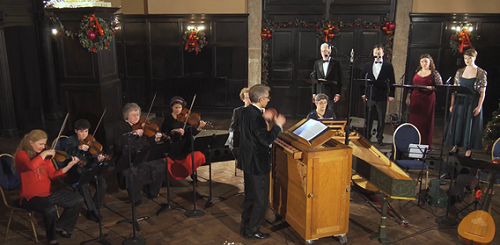
Most of Bach’s cantatas date from his Leipzig years as cantor at Saint Thomas Church but there are 30 or so from the earlier periods the composer spent at Mülhausen and Weimar, and ‘Nun komm, der Heiden Heiland (BWV 61) is one such, first performed, and opening the liturgical year, in Weimar on 2nd December 1714. Characteristically, it is modelled on the Italian secular cantata, with its alternation of recitatives and da capo arias in which, here, the solo voices personify religious figures. The conventional framing chorale, however, is this case embedded within the French-style overture, the dotted rhythms of which Rachel Podger and Brecon Baroque brought to life with dance-like litheness.
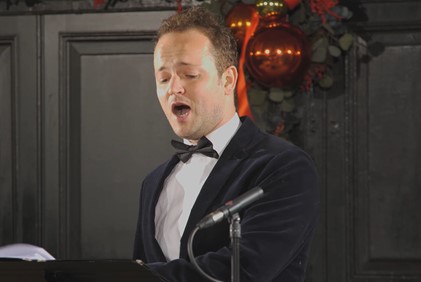
The initial pleas for the birth of the Saviour, “Nun komm”, were quite solemn in tone, though, earnest repetitions through which solo voice appeals built to ensemble supplication. Tenor Matthew Long anticipated the arrival of Christ, his recitative supported by Alex Rolton’s lovely supple cello line and flowering into the flowing jig-like aria ‘Komm Jesus, komm zu deiner Kirche’, which was intensified by Long’s heightened repetitions, “Komm”, the growing excitement of which Hollingworth let unfold with minimal directorial gesture. Christ’s pronouncement of his arrival, ‘Siehe, ich stehe vor der Tür’, elegantly sung by bass Charles Gibbs, was heralded by the violins’ soft ‘door-knocking’ pizzicatos and gently reiterated pedal notes in the cello and organ, and celebrated by the sweet freshness of soprano Elspeth Piggott’s petition, ‘Öffne dich, mein ganzes Herz’. Here, the gracefully running cello line and the warm blend of harpsichord and organ conveyed spiritual comfort and joy, which overflowed into the urgent appeals of the final chorus, “bleib nicht lange!” – do not delay!
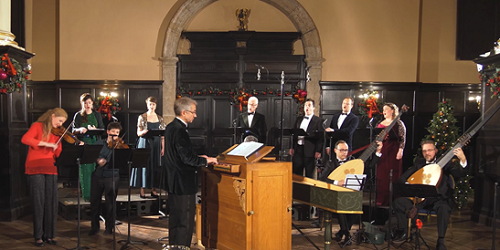
Interestingly, when, in 1722, Bach presented this cantata in support of his application for the post at the Thomasschule it was deemed overly theatrical. Monteverdi would surely have judged differently, his Beatus Vir demonstrating they extent to which he imported the gestures of secular dance, madrigal and opera into his own sacred music. The gravity of the opening plainchant was swept aside by the exuberance of the dance in which paired partners, both voices and violins, exchanged phrases with exuberance and delight, their figurative feet barely touching the ground. The fuller textures of the slower triple-time central section brought things down to earth, the violins’ elegant inter-phrase commentary hinting at a suppressed energy which would unwind itself effortlessly as the voices flew into the reprise of delight in the believer’s blessed state, “Beatus vir”. The cradle-rocking undulations of Byrd’s a cappella ‘Lullaby’ soothed and smoothed down the Monteverdian sprightliness, the lines so velvety and fluent that it was difficult to tell where one phrase ended and the next began, as the blanket of vocal warmth enveloped.
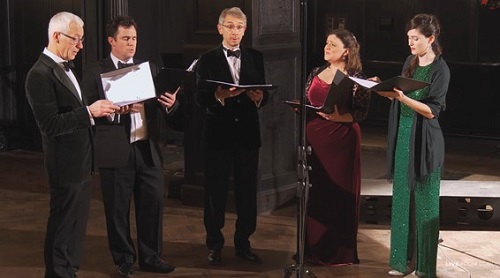
Then, the fun started.
Hollingworth introduced Cristoforo Caresana’s Christmas Cantata, La Tarantella, as a Neapolitan pantomime with ‘look behind you’ theatrics and an earthy response to the characters in the Nativity story: soporific shepherds, chastising cherubim, and the Devil and his infernal spirits. He wasn’t exaggerating. Little was known about Caresana (c.1640-1709) until, in the 1990s, the Italian conductor, musicologist and composer Antonio Florio discovered and subsequently recorded the composer’s Nativity cantatas with the Cappella della Pieta de’Turchini. But, Caresana was one of the most important composers working in Naples in the late seventeenth century, before the arrival of Alessandro Scarlatti. Born in Venice, Caresana was just a teenager when he moved to Naples where, from 1688, he taught in one of Naples’ four conservatoires, the Conservatorio di Sant’Onofrio; and it was the Neapolitan students who performed his sacred cantatas on specific days of the liturgical year. La Tarantella is one several cantatas written between 1670-83 – alongside La Pastorale, La Caccia del Toro, and La Vittoria dell’Infante and other works – that form a group, ‘per la Nascita del Verbo’.
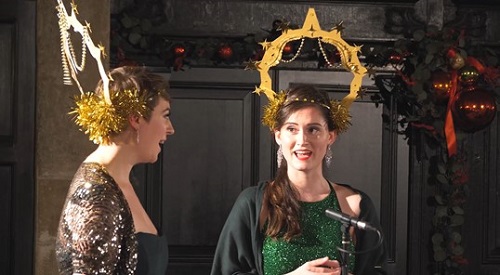
Undeniably theatrical, they contain elements of commedia-like caricature. Personifications of good and evil do battle and the birth of Jesus ensures victory for the righteous, thereby confirming Catholic Counter-Reformation dogma. One effusively labelled cantata, Demonio sotto abito di bifolco, et Angelo sotto forma di pastore, et 3 Pastori (1676) pits Angels in the form of shepherds against a Devil who assumes diverse disguises – perhaps this inspired Hollingworth’s programme title? – but, if in these cantatas the Devil is more the panto baddie than fearsome harbinger of damnation, and the drama doesn’t run very deep, then Caresana’s music is beautifully expressive, the rhythms and melodies wonderfully responsive to situation and character, and the units crafted into a pleasingly coherent whole. Hollingworth and I Fagiolini balanced Neapolitan high spirits with English drollness, the merry brio never tipping over into melodramatic clowning, the music always transcending the mischief.
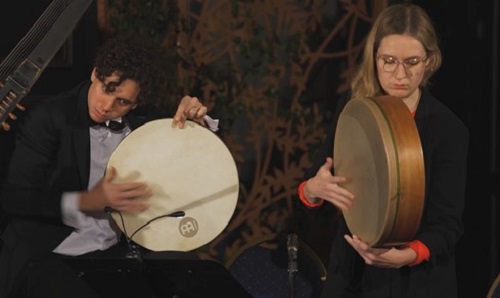
The cantata begins with the attempt by two Angels – here the seraphic blend of Elspeth Piggott and Ana Beard-Fernandez, complete with gilded haloes – but so reluctant did the sleepy shepherds prove to rouse themselves from their slumber that an introductory ‘Pifa’ had to be ‘borrowed’ from Handel’s Messiah to provide some percussive thumps and thwacks, and jolt the sulky ‘shepherds abiding in the fields’ into action. Once awake, the hapless herders – Silvio, Ergasto and Mirtillo (Nicholas Mulroy, Matthew Long and Charles Gibb) – were startled and stirred by the urgent echoes – “God!”, “Run!”, “Go!”, “Divine!”, “Messiah!”, “Born!” – which resonated from the various reaches of St Anne and St Agnes (and beyond – the VOCES8 technical team had some fun), and followed the Angels’ compelling command to take to the high road as Mary awaited them. They set off with a spring in their step which transformed itself into the eponymous circling dance, the initial slow toe-tapping pulse of the guitar, theorbo and violins gradually releasing its dynamic verve – recalling the ostinato dancing of Beatus Vir – initiating a hypnotic interchange of voices and violins so charmingly captivating that one might have wished for it never to end.
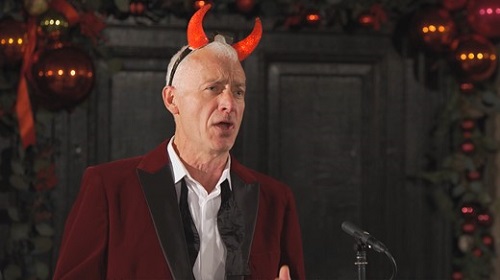
But, the Devil needed to be defeated and so some swift ‘costume’ changes – Gibbs’ woolly hat swapped for some kitsch plastic horns – brought Pluto before us. Singing now from memory, Gibbs captured all of Lucifer’s melancholic misery, as this “blind king of a cursed empire” sank down – dark, deep and black – in wretched abjection: “The stars smiling threaten eclipses. Babylon trembles already, the abyss is defeated.” Cue celestial trumpets and eternal jubilation – and a remarkable vocal juxtaposition of crystalline, stratospheric purity and black Plutonic desolation – as the Shepherds rejoiced at such a wondrous night.
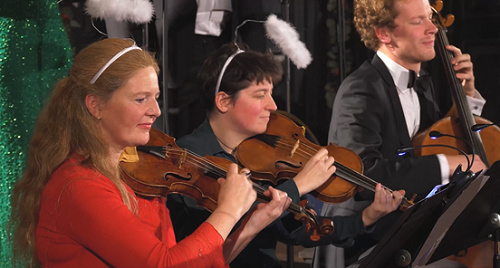
It was hard to imagine what could possibly follow Caresana’s masterly festive miniature but a villancico, ‘Xacara de Navidad’, by Juan Francés de Iribarren (1699-1767) – who served as maestro de capilla at the Cathedral at Málaga from 1733 until just before his death – proved the perfect finale, blending art and folk music in a vivacious romp of castanet-fuelled boisterousness and joie de vivre. Christ’s knocking at the door was now transformed into flamboyantly-fingered pizzicato riffs from the Brecon Baroque string players – Rolton bent his cello strings like a jazz-bassist born – and vocal yelps and whirrs were thrown into the musical mix as the six singers swerved skilfully through the rapid syllables of the Spanish text.
At the close, Matthew Long – who had stepped into the breach at only a couple of days’ notice – flung his red rose at a surprised Ana Beard-Fernandez. But, then, as de Iribarren reminds us, “Vaya pastores de fiesta – ¡vaya!” – “Party fiends these shepherds are – let’s go!”
Claire Seymour
I Fagiolini: Elspeth Piggott & Ana Beard-Fernandez (soprano), Martha McLorinan (mezzo-soprano), Nicholas Mulroy & Matthew Long (tenor), Charles Gibbs (bass), Louise Duggan & Zands Duggan (percussion), Catherine Pierron (harpsichord) Robert Hollingworth (director/organ)
Brecon Baroque: Rachel Podger (violin/director), Kinga Ujszászi (violin), Jane Rogers & Emilia Benjamin (viola), Alex Rolton (cello), Eligio Quinteiro & Arngeir Hauksson (guitar/theorbo)
Angels and Demons: J.S. Bach – Nun komm, der Heiden Heiland (BWV 61), Monteverdi – ‘Beatus Vir, Byrd – ‘Lullaby’, Handel – Pifa (from Messiah), Cristoforo Caresana – La Tarantella, Juan Francés de Iribarren – ‘Xacara de Navidad’
VOCES8 Centre, St Anne and St Agnes, City of London; Friday 24th December 2021.
ABOVE: Nicholas Mulroy, Matthew Long and Charles Gibbs